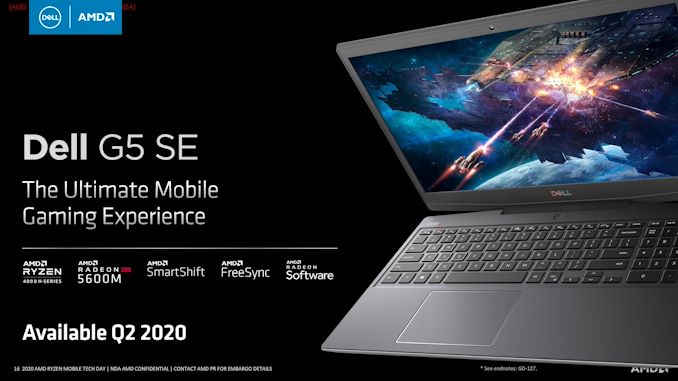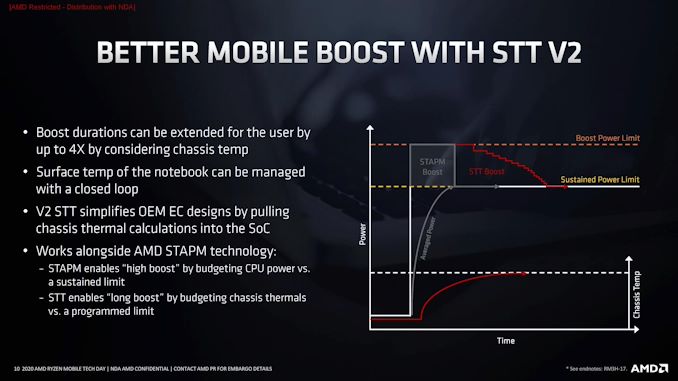AMD Details Renoir: The Ryzen Mobile 4000 Series 7nm APU Uncovered
by Dr. Ian Cutress on March 16, 2020 11:00 AM ESTAMD SmartShift
We’ve covered AMD’s SmartShift before, when it was announced at CES, as a technology that allows a system management controller to interact with both the mobile APU and an AMD graphics card in the same system in order to shift power where it is needed. This solution is still based on separate power rails between the two, however the use of the scalable control fabric (SCF) part of Infinity Fabric means that parts of the APU and parts of the GPU can interact together in this way. Ultimately AMD believes they can score 10-12% better on heavy CPU workloads like CineBench or gaming workloads like The Division.
The solution is firmware based, but requires interaction between qualified hardware. AMD states that often in these sorts of CPU+GPU designs, while the chassis has a total design TDP, if one of the elements of the system is idle, then the other can’t take advantage of the extra turbo headroom available. SmartShift aims to fix that.
What’s new here is that AMD is primarily focus will be on Ryzen Mobile 4000 + Vega 10 style systems. The first one with SmartShift enabled will be the Dell G5 SE. The Dell G5 SE is being labelled as ‘the ultimate mobile gaming experience’, and will feature a new H-series processor, the Radeon RX 5600M, SmartShift, FreeSync, and have a 15-inch display. The unit will be coming out in Q2.
System Temperature Tracking (Version 2)
SmartShift is also part of a new System Temperature Tracking paradigm that AMD is implementing in its new APUs. Even if there is power headroom, a system can’t turbo if there isn’t thermal headroom. Smart Temperature Tracing v2 (or STTv2) is designed to help a system boost for longer by knowing more about the thermal profile of the device.
My placing additional thermal probes inside the system, such as on hot controllers or discrete GPUs, the readings of these can be passed through the Infinity Fabric to an embedded management controller. Through learning how the system thermals interact when different elements are loaded, the controller can determine if the system still has headroom to stay in turbo for longer than the current methodology (AMD’s Skin Temperature Aware Power Management). This means that rather than having a small number of sensors getting a single number for the temerpature of the system, AMD takes in many more values to evaluate a thermal profile of what areas of the system are affected at what point.
What STTv2 does at the end of the day is potentially extend the boost time for a given system, depending on its thermal capabilities. For example, the Lenovo Yoga Slim 7 which we are expecting for review only has a 15 W processor inside, but the chassis has been built for a 25 W TDP design, which means that STTv2 should kick in and provide the user with peak performance for longer.














95 Comments
View All Comments
R3MF - Monday, March 16, 2020 - link
Tell me about [desktop] Renoir...?Ian Cutress - Monday, March 16, 2020 - link
Not yet. As far as I know, AMD is focusing on mobile first, so you'll have to come back later in the year. I suspect they'll time the launch of B550 around the same time.R3MF - Monday, March 16, 2020 - link
thank you (including for the article - which is a great read).thinking about the possibility of desktop Renoir, its interesting that:
a) on the media engine side - there is no sign of AV1
b) on the display output side - there is no mention at all (inc hdmi 2.1)
it seems to me that AMD would have a real opportunity to grab the HTPC market if it achieved both of the above.
do you think there is any chance that
1. the lack of AV1 is a function of speed, i.e. a 65W Renoir media engine might have the grunt to do it?
2. the absence of information on the display output side is deliberate, i.e. AMD is holding this back for desktop?
Moizy - Monday, March 16, 2020 - link
Media encoding/decoding capabilities are certainly important, but it seems like the "HTPC market" has dwindled into a really, really small niche, too small to influence design decisions in and of itself. But that's just my perspective, don't have actual data. It's just so cumbersome compared to streaming.DanNeely - Monday, March 16, 2020 - link
Yeah. HTPC is dead as far as driving features; streaming (games, etc) and video editing are the drivers for encoding support on the PC these days.a5cent - Monday, March 16, 2020 - link
Seems like everything I care about is niche :-/HTPC barely a blip on the radar and finally, after years of waiting, maybe, MxGPU support, or something GVT-g compatible. Make it happen AMD. Report on it Anandtech!
close - Tuesday, March 17, 2020 - link
Well HTPC is an unfortunate combination of things that can be delivered in many other ways now that technologies are shifting (mostly to mobile and streaming). Most people no longer want a (relatively) bulky and expensive full PC in their media lineup. They might have a NAS that can do it all (storage for the whole network, streaming, transcoding, output directly to TV, etc.) at a fraction of the cost, size, and effort to build and maintain. Between this and a smart TV the role of the HTPC is purely to make some enthusiasts happy.WaltC - Tuesday, March 17, 2020 - link
I love my "expensive" PC, thank you...;) I would not trade it for a device, ever.Threska - Tuesday, March 17, 2020 - link
HTPC might, but the NAS market is still there, and that's where the functionality has folded. This APU would fit right in and be an improvement of the usual anemic CPUs used in such machines.Namisecond - Thursday, March 26, 2020 - link
A NAS based on one of these APUs would also be in the price range of "enthusiast" or entry-level "enterprise" appliances. To the point that it might be more cost-effective to roll your own, especially to people who are picky enough to request this level of power and functionality from their NAS devices.